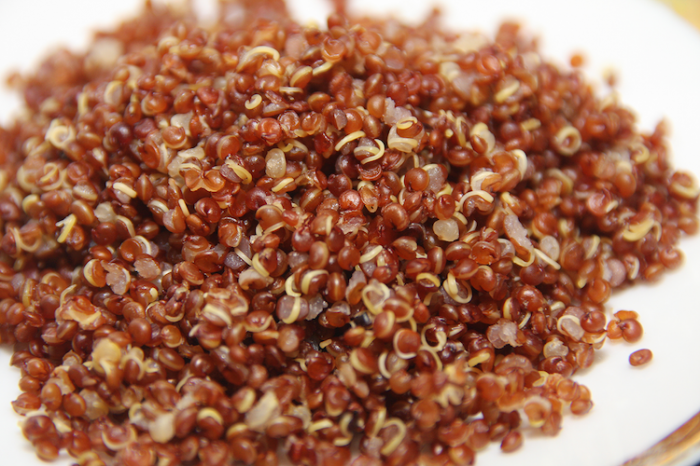Anything made with yeast, gelatin, figs (hotly debated), honey (read for a vegan beekeeper’s perspective), animal fat in kegs/wine production…what else? Please comment below!
I had no idea I’d been serving these up, until a customer asked.
There are a handful of sit down and take out spots that I frequent where the fare is completely vegetarian or vegan, and advertised as so.
This takes the guess work out of scouring the menu for something I can actually eat, an all too familiar and disappointing scavenger hunt I find myself in at most restaurants, including ones I’ve worked at.
In conventional restaurants, menu items with “veggie” in the title or ones that aren’t a main meat dish are not always vegetarian, nor are they intended to be. This marketing tactic is more often geared towards those looking for something lighter or healthier.
While it is refreshing to see more and more establishments adding—and labeling—which of the meals offered are alternative and in fact vegetarian dishes, a lot of the burden is still on us diners.
Behold a cruelty-free eater’s worst nightmare: chicken stock (and chicken broth). The backbone of most cooking recipes, these two ingredients—more like condiments—are made from simmering the meat and bones of chickens—and likely not cage-free, grass-fed ones.
However, cooks are not by any means trying to dupe their diners by using chicken stock and broth, hence why there is no disclaimer on the menu. To them, it’s just another staple, like salt or pepper or even water, which many dishes require in order to be cooked properly and taste perfectly, as a meal ordered out should be.
They say everyone should work in food service for the character qualities it instills—patience, generosity, gregariousness. I certainly developed all of these merits after five years of working in the front and back of the house. But I also gained something far more valuable: a behind the scenes look at what actually goes into the food we order.
Don’t worry; this isn’t some kind of gruesome tell-all where I leave you questioning the sanitation of even grade-A restaurants. It is a warning, though.
I can recall the day a customer asked if the lentil soup was vegetarian—I said of course it was. She then asked if I knew for certain that there was no chicken stock or any animal stock in it, which would make it unsuitable for her vegetarian diet. I was stumped and had to run down to the kitchen. Turns out the lentil soup wasn’t safe.
Depending on how you define your diet, the ingredients listed in the meal descriptor on the menu do not necessarily define what’s in your dish. Before you send your waitress back to the kitchen in tears or stiff her on the tip, consider the following dishes I’ve had to serve that, seem meatless, yet are anything but.
- Ratatouille: On paper this French side dish—also suitable as a main course when the portion is increased or it’s served over a grain—seems like the perfect vegetarian choice. Eggplant, zucchini, tomatoes, basil, garlic…oh yeah, and (sometimes) fat from the bones of factory-raised chickens, pumped with preservatives for a long shelf life, especially when purchased in bulk.
- Risotto: Creamier and heartier than rice, this grain-based dish is usually cooked in chicken broth or stock to add flavor and texture—again, from the lipids of the simmering animal parts. The mushroom risotto would be an even more dangerous choice, as those baby bellas were likely braised in stock or broth. Which brings me to…
- Any braised vegetable side dish: Brussel sprouts, asparagus, haricots verts—these all need to be tenderized to an extent to enjoy. The quick fix during a weekend rush? Chicken stock/broth.
- Quinoa: This one is the biggest trickster. A current trend in restaurants and health food stores, quinoa is a great, gluten-free alternative to a lot of grains and starches, plus it is high in protein and is a suitable substitute to a meat entrée. Served hot or cold, quinoa goes great with almost anything mixed in. But, unless you ask your server, there’s a chance that, like the risotto, this dish was cooked in stock or broth for flavor.
- Soup: Whether broth or cream based, most soups—yes, even lentil soup—are often made with chicken stock or broth.
All of these dishes can be made using vegetable stock, or even just hot water, when you make them at home. For quinoa I boil it in water then add fresh lemon or lime juice. EVOO, sea salt, and black pepper are also your best friends for prepping these meals just right, sans chicken parts. And if you’re eating out, there is a simple solution to avoiding eating dishes containing animal parts, if that’s your dietary goal—just ask.
Bonus video:
Relephant reads:
5 Healthy Foods that Aren’t that Healthy
Vegan on the Cheap
~
~
Love elephant and want to go steady?
Sign up for our (curated) daily and weekly newsletters!
~
~
Editor: Travis May
Photo: Wiki Commons
 Share on bsky
Share on bsky


Read 44 comments and reply